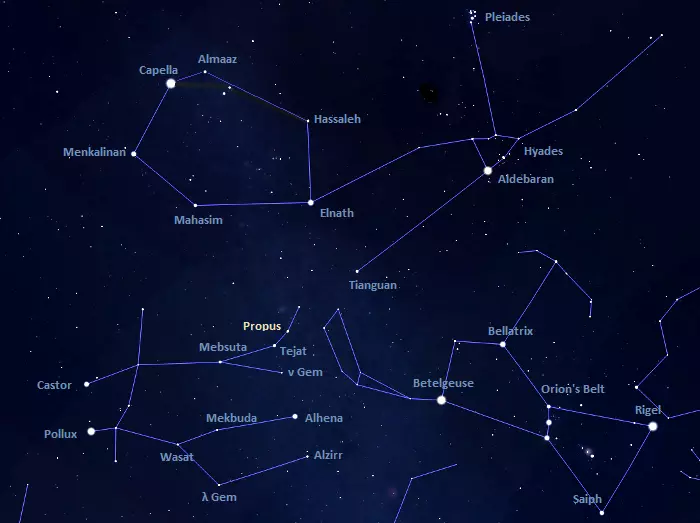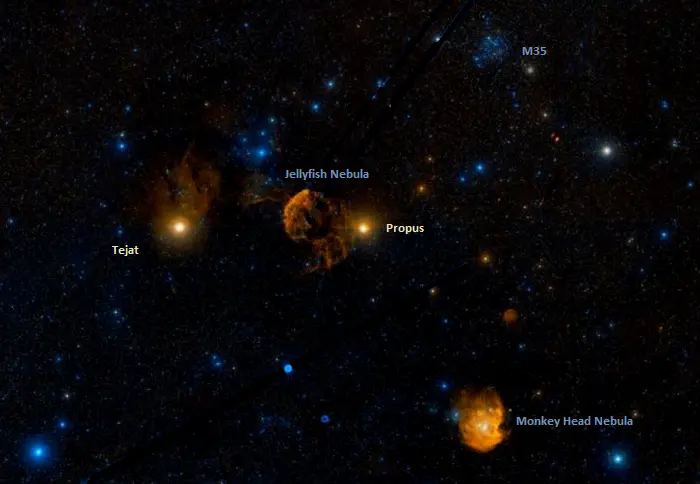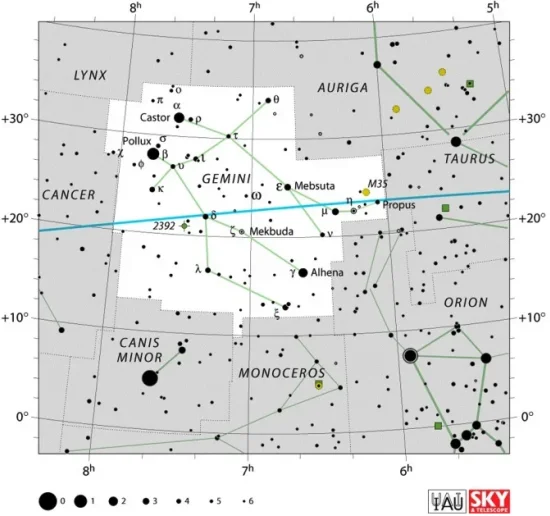Propus, Eta Geminorum (η Gem), is the primary component in a triple star system located approximately 700 light-years away in the constellation Gemini. It is a red giant star whose brightness varies from magnitude 3.15 to 3.90. On average, it is the sixth brightest star in Gemini. It marks the foot of Castor, one of the celestial Twins.
Star system
Eta Geminorum is a triple star system consisting of a spectroscopic binary star, Eta Geminorum A, and a third component, the 6th magnitude yellow giant Eta Geminorum B.
Eta Geminorum A is composed of a red giant star and a faint M-type companion. The red giant, formally named Propus, has a mass of 2.5 solar masses and a radius 275 times that of the Sun.

Propus (Eta Geminorum), image: Wikisky
Propus is a star on the asymptotic giant branch, a highly evolved giant fusing hydrogen and helium in shells around the largely inert carbon-oxygen core. With an effective temperature of 3,502 K, the star is 10,276 times more luminous than the Sun. It has an estimated age of 0.81 billion years.
The close M-type companion star cannot be visually resolved. Its existence was inferred from radial velocity variations in the primary star. The star is believed to have a circumstellar disk.
American astronomer William Wallace Campbell was the first to propose that Eta Gem A was a spectroscopic binary in 1902, but this was not confirmed until much later.
The two components, Eta Geminorum Aa and Eta Geminorum Ab orbit each other with a period of 2,983 days (8.161 years) and an eccentricity of 0.5507. They have a semi-major axis of 0.0077 arcseconds.
The two stars eclipse each other during their orbit and the system is classified as an Algol variable. It has a period of about 8 years, corresponding to the orbital period. The eclipses last for several weeks, during which the system’s brightness drops by about half a magnitude.
Eta Geminorum Aa is also classified as a semiregular variable of the type SRa. It is the brightest SRa variable in the sky. Its brightness variations have a main period of about 234 days. Secondary periods have not been detected.
These types of variable stars (SRa) are typically red giants, carbon stars, and S-type stars with relatively stable periodicity and small amplitudes of light variation. They are similar to the pulsating red giant Mira (Omicron Ceti) and Mira-type variables, but their brightness variations have smaller amplitudes.
Eta Geminorum A and Eta Geminorum B have an orbital period of 473.7 years and are separated by 1.65 arcseconds in the sky. Eta Geminorum B is believed to be a yellow giant star of the spectral type G0V.
Facts
The German-born British astronomer William Herschel discovered Uranus near Propus and Tianguan (Zeta Tauri) on March 13, 1781. This was the first discovery of a planet with the aid of a telescope.
Propus was first reported to be a variable star by German astronomer Julius Schmidt in 1865. Schmidt reported observing brightness variations with long maxima of constant brightness and minima of varying size and shape. He found a variation period of about 231 days.
Propus lies only 0.9 degrees south of the ecliptic and is subject to lunar occultations. It can also be occulted by planets, but this happens very rarely. The last two recorded occultations took place in July 1910, when the star was occulted by Venus, and in July 1837, when it was occulted by Mercury.
In Arabic astronomy, Propus formed an asterism known as Al Han’ah (meaning “the brand”) with Tejat (Mu Geminorum), Alhena (Gamma Geminorum), Alzirr (Xi Geminorum), and Nu Geminorum. The asterism represented a brand on the neck of a camel. It is commemorated in the name of Gamma Geminorum, Alhena. The stars were also sometimes called al-nuḥātai, which is the dual form of al-nuḥāt, meaning “the camel’s hump.”
Name
The name Propus (pronunciation: /ˈproʊpəs/) is the Greek word for “forward foot.” It refers to the star’s position in the constellation Gemini, at the foot of one of the Twins. The name was mentioned in the works of the Greek astronomers Hipparchus (c. 190 – c. 120 BCE) and Ptolemy (c. 100 – c. 170 CE). It was historically also spelled Propos, Propous or Praepes.
The name Propus was approved by the International Astronomical Union’s (IAU) Working Group on Star Names (WGSN) on July 20, 2016. It formally applies only to the component Eta Geminorum Aa but has traditionally been used for the entire star system.
Eta Geminorum was traditionally also known as Tejat Prior and Pish Pai (derived from the Persian word Pīshpāy, meaning “foreleg”). The nearby Mu Geminorum was called Tejat Prior and is now formally known as Tejat.
The Latin author Hyginus (c. 64 BCE –17 CE) called Eta Geminorum Tropus. The name is derived from the ancient Greek τρόπος, meaning “turn.” It referred to the apparent turning point of the Sun at the summer solstice, which once lay near the star. The English astronomer John Flamsteed (1646 – 1719) called Eta Geminorum by a similar name, Tropos.
In Chinese astronomy, Propus was the only star in an asterism called 钺 (Yuè), Battle Axe. The asterism was part of the Well mansion, one of the southern mansions of the Vermilion Bird.
Location
Propus is easy to find but challenging to see from light-polluted areas. It appears at the foot of Castor, only 2 degrees west of the slightly brighter Tejat (Mu Geminorum).
The two stars can be found by extending a line from Alnitak, the leftmost star of the Belt of Orion, through Betelgeuse at Orion’s shoulder. Alternatively, they appear on the imaginary line extended through the southern horn of the Bull, from Aldebaran (Alpha Tauri) in the Bull’s head through Tianguan (Zeta Tauri), the star marking the tip of the horn.

The location of Propus (Eta Geminorum), image: Stellariun
Tejat and Propus appear in the same line of sight as several well-known deep-sky objects. The bright open cluster Messier 35 lies 2 degrees northwest of Propus. It is one of the finest sights in small telescopes.
The Jellyfish Nebula (IC 443), a supernova remnant about 5,000 light-years away, appears next to Propus, in the direction of Tejat. The Monkey Head Nebula (NGC 2174), an emission nebula in the Orion constellation, appears southwest of Propus.

Tejat, Propus, the Jellyfish Nebula, the Monkey Head Nebula, and Messier 35, image: Wikisky
Constellation
Propus is located in the constellation Gemini. Representing the celestial Twins Castor and Pollux, Gemini is one of the Greek constellations, catalogued by the Greco-Roman astronomer Claudius Ptolemy of Alexandria in his Almagest in the 2nd century CE.
Gemini is one of the most distinctive zodiac constellations. The stars marking the heads of the Twins, Pollux and Castor, are the 17th and 23rd brightest stars in the sky. Pollux (Beta Geminorum) is an orange giant 33.78 light-years away and Castor (Alpha Geminorum) is a multiple-star system 51 light-years away.

Gemini constellation map by IAU and Sky&Telescope magazine
Other interesting stars in the constellation include the yellow supergiant Mebsuta (Epsilon Geminorum), the variable yellow-white supergiant Mekbuda (Zeta Geminorum), the spectroscopic binary star Gamma Geminorum (Alhena), and the dwarf nova U Geminorum.
Notable deep-sky objects in Gemini include the bright open cluster M35, the planetary nebulae NGC 2392 and the Medusa Nebula (Sh2-274), and the supernova remnant IC 443 (the Jellyfish Nebula).
The best time of the year to observe the stars and deep sky objects of Gemini is during the month of February, when the constellation appears high above the horizon in the evening. The entire constellation is visible from locations north of the latitude 60° S.
The 10 brightest stars in Gemini are Pollux (Beta Gem, mag. 1.14), Castor A (Alpha Gem A, mag. 1.93), Alhena (Gamma Gem, mag. 1.9), Tejat (Mu Gem, mag. 2.86), Castor B (Alpha Gem B, mag. 2.97), Mebsuta (Epsilon Gem, mag. 3.06), Propus (Eta Gem A, mag. 3.15 – 3.90), Alzirr (Xi Gem, mag. 3.35), Wasat (Delta Gem, mag 3.53), and Kappa Geminorum (mag. 3.568).
Propus – Eta Geminorum
| Spectral class | M2 IIIa + G0 III |
| Variable type | Semiregular variable + Algol variable |
| Apparent magnitude | 3.15 – 3.90, 6.04 |
| Absolute magnitude | -1.87 |
| Distance | 700 light-years (210 parsecs) |
| Parallax | 4.7312 ± 1.0207 mas |
| Radial velocity | 22.39 ± 0.36 km/s |
| Proper motion | RA: −59.530 ± 1.450 mas/yr |
| Dec.: −7.766 ± 1.385 mas/yr | |
| Mass (η Gem Aa) | 2.5 M☉ |
| Luminosity (η Gem Aa) | 10,276 L☉ |
| Radius (η Gem Aa) | 275 R☉ |
| Temperature (η Gem Aa) | 3,502 K |
| Metallicity (η Gem Aa) | +0.04 dex |
| Age (η Gem Aa) | 0.81 billion years |
| Constellation | Gemini |
| Right ascension | 06h 14m 52.5766173086s |
| Declination | +22° 30′ 24.313254950” |
| Names and designations | Propus, Eta Geminorum, η Gem, 7 Geminorum, HD 42995, HR 2216, HIP 29655, SAO 78135, BD+22°1241, AG+22 665, GC 7969, GCRV 3940, PPM 95649, JP11 1342, PLX 1444.00, IRAS 06118+2231, 2MASS J06145266+2230244, UBV 21376, AAVSO 0608+22, WEB 5839, TYC 1877-1716-1, Gaia DR2 3377072212925223424, Gaia DR3 3377072212924335488, DO 12034, BU 1008A, ADS 4841, CCDM J06149+2230, IDS 06088+2232 A, WDS J06149+2230A |